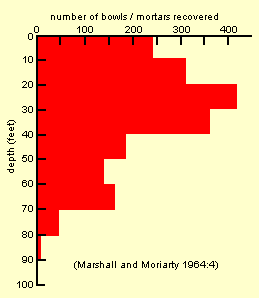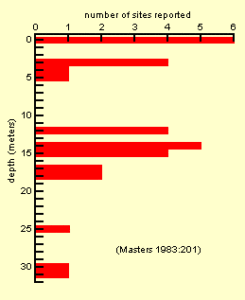Submerged Sites
Numerous prehistoric artifacts have been recovered from locations that are presently submerged off the San Diego coast. These remains raise questions relating to their possible deposition during Pleistocene or early Holocene times when sea level was substantially lower than at present and the coastline lay substantially farther west.
In the early 1900s, children diving off a beach in La Jolla are reported to have found small stone bowls or mortars underwater at shallow depths (Carter 1980).  Notes by Malcolm J. Rogers indicate that in 1925 he found artifacts in crevices in a reef off La Jolla that was exposed at low tide (Tuthill and Allanson 1954:227; see also Carter 1955:22). Beginning in the early 1950s, after scuba gear had made sustained diving more practicable, divers found hundreds of submerged bowls or mortars. By far the largest sample of artifacts came from near La Jolla, but a large collection was also reported off Solana Beach. At least 34 submerged San Diego “sites” were identified, but only one to three artifacts have been reported from most of these (Masters 1983). The artifacts were found as deep as 30 m, and as far as 800 m west of the present shoreline. Reports and interpretive discussions concerning the finds from local submerged sites have been offered by Carr Tuthill and A. A. Allanson (1954), George F. Carter (1955, 1957, 1980), Margaret Thornburgh (1956), Neil F. Marshall and James R. Moriarty (1964), and Patricia M. Masters (1983, 1985). Dee Travis Hudson (1976) discussed similar issues for underwater sites in the Santa Barbara region.
Notes by Malcolm J. Rogers indicate that in 1925 he found artifacts in crevices in a reef off La Jolla that was exposed at low tide (Tuthill and Allanson 1954:227; see also Carter 1955:22). Beginning in the early 1950s, after scuba gear had made sustained diving more practicable, divers found hundreds of submerged bowls or mortars. By far the largest sample of artifacts came from near La Jolla, but a large collection was also reported off Solana Beach. At least 34 submerged San Diego “sites” were identified, but only one to three artifacts have been reported from most of these (Masters 1983). The artifacts were found as deep as 30 m, and as far as 800 m west of the present shoreline. Reports and interpretive discussions concerning the finds from local submerged sites have been offered by Carr Tuthill and A. A. Allanson (1954), George F. Carter (1955, 1957, 1980), Margaret Thornburgh (1956), Neil F. Marshall and James R. Moriarty (1964), and Patricia M. Masters (1983, 1985). Dee Travis Hudson (1976) discussed similar issues for underwater sites in the Santa Barbara region.
By far the most common type of artifact that has been reported is a small portable mortar (Carter 1955, 1957; Marshall and Moriarty 1964; Masters 1983; Thornburgh 1956; Tuthill and Allanson 1954) or a bowl (Carter 1980). These specimens were described as typically about 20 cm in diameter and 7.5 cm thick. Perhaps arguing against their use as mortars is the fact that most of the specimens were made from friable sandstone, which would have introduced a substantial amount of grit into any material that was ground in them.  Also noteworthy is the scarcity of associated stone pestles; however, materials other than stone might have been used as pestles, or stone pestles may have been overlooked by the divers. Other artifact types that have been reported in much smaller numbers from the submerged sites include manos, metates, pestles, net weights, scrapers and projectile points.
Also noteworthy is the scarcity of associated stone pestles; however, materials other than stone might have been used as pestles, or stone pestles may have been overlooked by the divers. Other artifact types that have been reported in much smaller numbers from the submerged sites include manos, metates, pestles, net weights, scrapers and projectile points.
Several alternative explanations have been offered to account for the presence of these artifacts in their submerged locations:
- The artifacts may mark locations that were occupied during the Pleistocene or early Holocene but were subsequently drowned by the rising Holocene sea. This interpretation was generally favored by Carter, Marshall and Moriarty, and Masters. Masters observed that several of the concentrations of bowls or mortars coincide with areas that have extensive deposits of natural cobbles, and she suggested that these locations were prehistoric factories where the artifacts were being produced during a period of lower sea level. No confirming evidence in the form of manufacturing tools, aborted bowls/mortars, or associated debitage was reported (cf. Schneider and Osborne 1996). Masters also noted that the topographic circumstances of some of the smaller underwater sites made it highly unlikely that any early deposits at those locations could have been preserved in situ during the Holocene transgression.
- The artifacts may have originally been deposited in locations that would presently be above sea level, and they may subsequently have been redeposited in underwater locations as a result of either cliff erosion or river outwash. This interpretation was favored by Tuthill and Allanson, who doubted that the remains were old enough to have predated the early Holocene rise in sea level. Arguing against this hypothesis, Carter noted that flaking scars and pecking marks on the bowls/mortars have not been obliterated, suggesting that the artifacts could not have been transported very far by natural processes. Carter also noted that stone bowls are rarely found in later La Jolla or late prehistoric sites, but that these artifacts number in the thousands at the submerged sites.
- The artifacts may have been accidentally or intentionally dropped from prehistoric watercraft, possibly having served as net weights or anchors, or as artifacts associated with a ceremony. A small number of the recovered specimens that have medial grooves or necks might have been suitable for use as prehistoric net weights or anchors. Masters favored post-submergence deposition to explain some of the sites, suggesting that the numerous small mortars associated with kelp bed locations may have been carried in prehistoric watercraft and used for some function related to fishing, such as grinding chum, baiting fish traps, or preparing fish poisons (Hoover 1975; Masters and Gallegos 1997). Ethnographic evidence attests to the use of small stone bowls in the Luiseño toloache ceremony (DuBois 1908). The abundance of the bowls or mortars and their generally intact condition may suggest that their use was not strictly utilitarian, but their association with at least a few utilitarian artifacts weakens this argument.
- The prehistoric artifacts may have been taken from onshore archaeological sites and intentionally discarded offshore by modern land users. Carter reported but then dismissed this suggestion, which came from critics who were skeptical about his claims for early Pleistocene occupations in the region.
PROSPECTS
Future archaeological investigations may shed more light on the age, functions, and depositional contexts of submerged prehistoric archaeological remains off the San Diego coast. Intensive underwater studies may be able to provide a more complete picture of the other elements that are included in the assemblages that contain stone bowls/mortars. It may be possible to assess whether or not in situ features, such as hearths, are associated with the portable artifacts. Detailed analyses of recovered specimens may be able to identify manufacturing techniques, use wear, postdepositional damage, and conceivably even organic residues. Closer analysis of the submerged site contexts may clarify the artifacts’ associations with locations that would have been desirable for prehistoric settlement, and with areas that were either exposed to or protected from strong erosional forces during the early Holocene marine transgression.